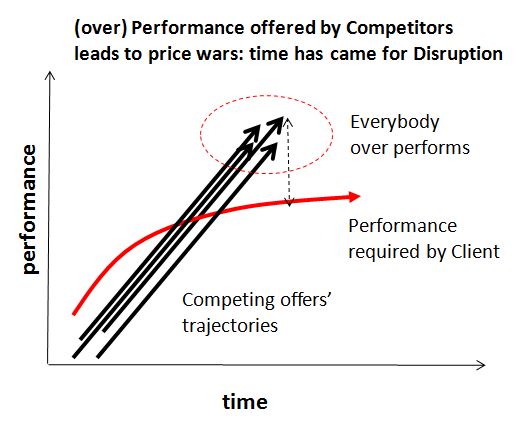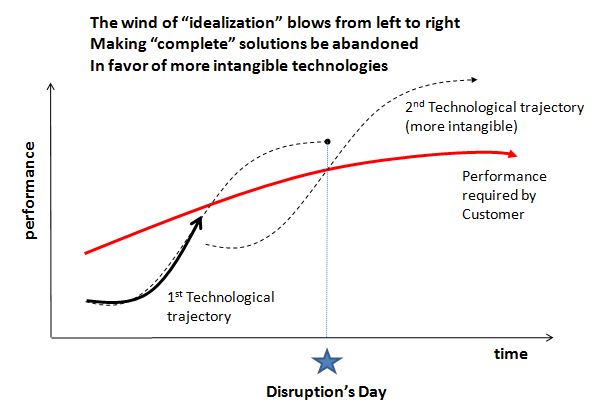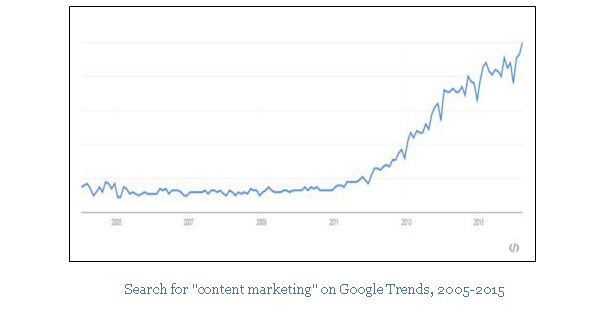
|
4 ways to innovate in the Internet of Things Era |
|
4 ways to innovate in the Internet of Things era
|
|
No matter if you are a Big Corporation or a Small Medium Business Dear Fellow Innovator,In this era of stagnating economy ( look at latest OECD data here ) Companies of any kind and size are struggling to understand where to find a Customer. This need is so urgent that failing to do so, is bringing the business down on a slippery slope, from which recovery it's almost impossible. *** But what to do to not loose momentum? *** I think there are at least 4 moves that respond to today's scenario changes · Inject new technology
· Upgrade or Downgrade to Market
· Hack the Business Model
· Invert Go To Market Direction
Let's see one at time: 1) Inject new technologyThis move responds to the commoditization of the solutions on the market.
The only way to move out from this trap is to jump on the next technology's trajectory. Here prof. Altschuller tell us what to do with his TRIZ methodology:
2) Upgrade or Downgrade to MarketGiven that your market is no more "receptive", the only other option is to move into another market. Ok. But which one? I want to build up on a couple of recent experiences I made. 1st case: Moving upwards to a more structured marketOne is a project where a supplier of jet engine components was stacked into his reference Energy market. This market is close linked with the GDP trend, where a growing economy pushes for more energy consumption. The Energy market and its supply chain is more and more market controlled. This means that the past drivers of sales ( the need for Countries to build an energy infrastructure ) is less of importance. The market is now leading the dance and commoditization is taking its tall. For this company the solution has been to move away from its orginal Energy market and point to a more (infra) structured one: the Aerospace and Defense. Aerospace and Defense trends are underpinned by political, not by market logics. And this drives a continuous push towards excellence. To support high performance, the Aerospace and Defense market shall continuously expand, deepening and upgrading its market's infrastructure, thus creating an environment where excellence can still emerge. The challenge here is to be able to manage the infrastructure ( systems, norms, regulations, networks, relationship etc ) complexity. This is the reason why, on my opinion, highly (infra) structured markets are receptive to the themes of Internet of Things. Iot is a way to manage complexity in autopilot. Conclusion 1 of 2:One way to move out of your market is to look upwards to the adiacent, more (infra) structured markets. But be ready to handle an added layer of complexity.(if you need a hand, you may be intrigued by the Internet of Things platform Zerynth, developed by a bunch of "young big brains" guys of the Pisa University. An enabling solution for all those companies that need to quick jump into the interactivity of Iot and M2M technology. Zerynth is registered in USA and has operations on both sides of the Atlantic Ocean.) 2nd case: Moving downwards to a less structured marketThe second case I want to offer to your attention is the support I give for a couple of years to an e-commerce startup targeting the Arabian market: Italy's Got Style The goal of the founder was to find a non saturated market for an Italian fashion e-commerce. This was not an easy task given that this very market spot is taken by a strong player like YOOX.com, a company listed in the Milan Stock Exchange. The idea was to target a quite unpresidiated market: the Arabian one. Arabia has more than a difficulty for a western entrepreneur: different culture, norms, regulations, business networks, calendar, shopping seasons, shopping habits, you can add. But the Entrepreneur was a Lebanese young guy with an incredible personal story and an Italian academic background. A perfect fit to build a bridge among the Italian Fashion and the Arabian lifestyle. Targeting the Arabian market however, has required a lot of in situ experiments and discovery. The Kingdom of Saudi Arabia is a fantastic place of opportunities, but is till in its infancy in terms of infrastructures. Just to name a few gaps (perhaps advantages?): · streets have no names · cash is the preferred method of payment ( if not the only one, considered the target consumer) · Internet is available, but through smart phones, because cable connectivity and therefore computers, are not deployed. Building an e-commerce to win this market niche requires to fully understand and maneuver into the market: not giving per granted infrastructures we normally use for our business models. Conclusion 2/2:the lack of infrastructure proved to be an opportunity. But to exploit it, it requires a first hand experience that can be acquired only living the local reality.( if you are thinking to make a bold move to places like Iran, Nigeria, India, Turkey and China, I may have some friend there who can help) 3) Hack the Business ModelLet's assume that the reason for loosing momentum is not a market fault. It's your fault. Probably it's time to hack your business model. I see at least two main drivers for business model obsolescence: · one on the front seat: Go to market, · one of the back seat: Value Chain. Let's start form this one: A) Value Chain obsolescence is caused by Know-How streaming technologiesthe race towards more intangible solutions has pushed the separation of hardware and software to the extreme, thanks to two new technologies, both enabling: Know-How Streaming. · The first Know-How streamer is 3D Printing. There is plenty of literature on the web. my point here is that 3D printing is enabling the adoptions of "iTunes" alike business models. iTunes allow you to listening to music without owning it. Today OEMs are very intrigued by the idea of "streaming" their product know-how to our 3D printer, so that we can e.g. get the replacement part we need, without stocking high value inventories, but just low value materials. · The second Know-How streamer is Drone Technology Here I require a bit of mental elasticity, but think to Drones as a de-coupling technology, exactly as 3D printing. What a Drone does, is to decouple information from location. Drones are an enabler of know-how streaming, just as 3D printing but in the opposite direction. From a place to a base, instead from a base to a place.
What is causing the front seat obsolescence? B) Go To Market obsolescence is caused by sharing economy modelsAlso on the front end of the business model the quest for de-materialization is disruptive. De-materializing the front-end of the business model means that "owning" something is going to be substitute by "using" something. It's about to reach the latest frontier of intangibility by externalizing the cost of ownership. The sharing economy is hacking more than a business model. is hacking entire industries. Uber, Air B&B, are big names, but this is happening al around you. Even a close friend of mine has started a venture where you can "rent" a driller from your neigh borough to hang that great New York Picture, instead of having to buy a full set of tools. (You can try it on LocLoc ) 4) Invert Go To Market DirectionThe final move to not to loose momentum is inverting your go to market direction. I talked extensively of why and what is happening in my post: "Why your marketing does not work anymore and how to fix it" Just to recap, I add here a graph taken from Google Trends that gives an idea of how much the smartphone technology has disabled the Get-Keep-Growth customers' acquisition mode of many companies in the last 3 years.
Content Marketing, Digital Marketing and Social Media Marketing, since the advent of mobile internet (just a couple of years ago, in terms of adoption) have reversed the go-to-market flow. Now you need to attract clients, and stop to chase clients. If your business model does not forecast an inbound marketing strategy and implementation, you should stop wonder why your Customers are no more in the place where you used to find them.
To recap:If you are stacked in a stagnating market niche, you should probably take into consideration to revisit your business model along one of these 4 directions: 1. Injecting de-materializing technology to recover marginality 2. Move to a market with a different infrastructure, in order to take advantage of different fundamental business principles and un-chain from your old customer base 3. Rethinking the way your company retains its share of value generated, decoupling the know-how stream with the use of 3D printing and Drone technology and thinking to externalizations of ownership. 4. Reversing the marketing flow, using content marketing to attract the customer, instead to hunt for customers. I hope that these 4 moves may help you find again a customer base. In case, just let me know the results. Cordialmente Flavio
To talk about this, Just give me a call at +39 349 648 2225 Cordialmente, Copyright © 2016 Business Exploration ®, All rights reserved. If you liked this post, get more of the kind. The best way to reward this post is with your "like"
|
|
Little nightly thoughts by Business Exploration® |
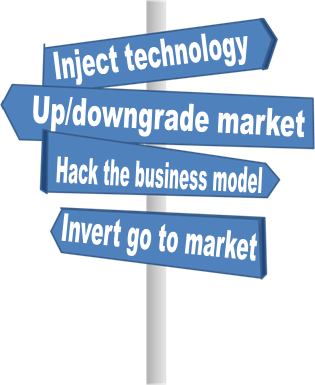
|
Read more about marketing innovation, Ask our free booklets: here |
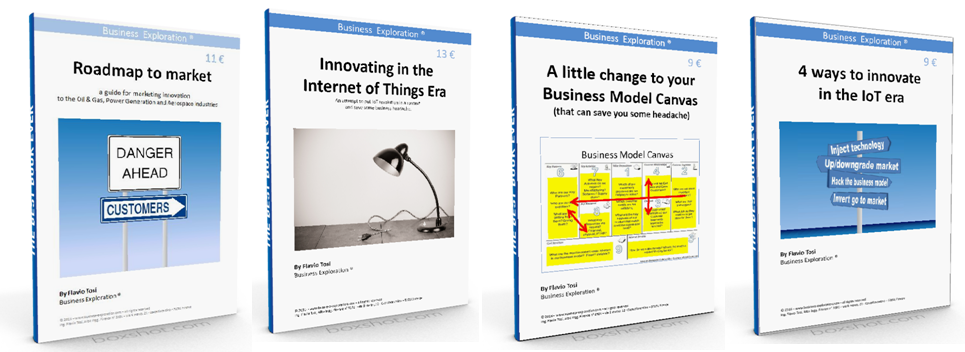
|
Puzzled by your Marketing Plan? |

|
Get our free booklet: Roadmap to Market
And discover our methodology
Satisfied or Reimbursed |
|
Our Newsletter reaches 2200 professionals in 47 nations, with the ambition to offer alternative points of view and a relax break to our readers. |



